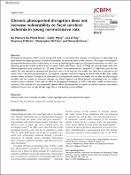Options
Chronic photoperiod disruption does not increase vulnerability to focal cerebral ischemia in young normotensive rats
Journal
Journal of Cerebral Blood Flow and Metabolism
Date Issued
2017
Author(s)
Ku Mastura Ku Mohd Noor
Cathy Wyse
Lisa A Roy
Stephany M Biello
Christopher McCabe
Deborah Dewar
DOI
10.1177/0271678X16671316
Abstract
Photoperiod disruption, which occurs during shift work, is associated with changes in metabolism or physiology (e.g. hypertension and hyperglycaemia) that have the potential to adversely affect stroke outcome. We sought to investigate if photoperiod disruption affects vulnerability to stroke by determining the impact of photoperiod disruption on infarct size following permanent middle cerebral artery occlusion. Adult male Wistar rats (210-290 g) were housed singly under two different light/dark cycle conditions (n=12 each). Controls were maintained on a standard 12:12 light/dark cycle for nine weeks. For rats exposed to photoperiod disruption, every three days for nine weeks, the lights were switched on 6 h earlier than in the previous photoperiod. T2-weighted magnetic resonance imaging was performed at 48 h after middle cerebral artery occlusion. Disruption of photoperiod in young healthy rats for nine weeks did not alter key physiological variables that can impact on ischaemic damage, e.g. blood pressure and blood glucose immediately prior to middle cerebral artery occlusion. There was no effect of photoperiod disruption on infarct size after middle cerebral artery occlusion. We conclude that any potentially adverse effect of photoperiod disruption on stroke outcome may require additional factors such as high fat/high sugar diet or pre-existing co-morbidities.
Subjects
File(s)
Loading...
Name
Chronic photoperiod disruption does not increase vulnerability to focal cerebral ischemia in young normotensive rats.pdf
Size
463.4 KB
Format
Adobe PDF
Checksum
(MD5):9db87dca7ae097647a81c8e74dbf8de0